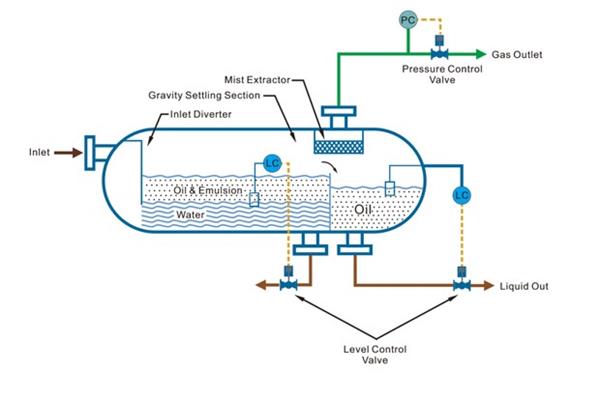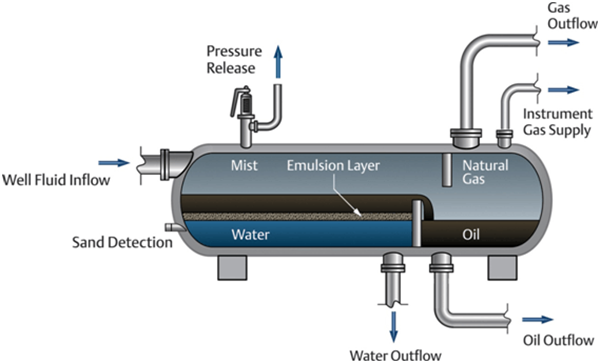Structure & working principle of three-phase separator
The three-phase separator is a commonly used equipment for oil field development and production. With the continuous intensification of exploitation, oil and gas resources are becoming less and less. How to provide more energy with the existing resources is one of the priority tasks now. Therefore, the recovery efficiency requirements of three-phase separators for users are more demanding than ever before.
Today, as a manufacturer of three-phase separators, HC will provide you with an in-depth analysis of the structure and working principle of three-phase separators along with some help for your choice.

Structure of three-phase separator:
A typical three-phase separator has three main zones:
(1)Primary separation zone: Most of the fluid phase can be separated in this zone. In the primary zone, an inlet diverter is used to suddenly change the direction and speed of fluid flow, so that most of the liquid droplets hit the diverter and fall due to gravity to realize the effect of separation.

(2)Gravity separation zone: The main part of the separator. In this gravity zone, the velocity of the gas and liquid phases is rather slow. During gas-phase flow, small droplets are separated from the flow by gravity. The gravity separation zone also includes the separation and aggregation of different liquid droplets under the action of gravity and buoyancy. The gravity separation zone is the key area for the safe and stable operation of the separation equipment, because there may be blockage or surge in this part.

(3)Mist elimination zone: Since droplets with extremely small size cannot be separated from the airflow in the gravity separation zone, it is necessary to set up a mist elimination zone to remove the remaining droplets in the gas phase through a mist removal device. In general, an impact plane is provided in the mist elimination zone where extremely small droplets can gather and form larger droplets, which are separated from the airflow by gravity.
Working principle of three-phase separator:
The working principle of the three-phase separator is based on the density difference of water/oil/gas. The gas-liquid separation is achieved by centrifugal force and gravity. In simple terms, in a three-phase separator, the separation is performed in the order of gas/liquid separation and then oil/water separation.

How to select the appropriate three-phase separator:
The selection of the three-phase separator in oilfield production is designed and customized based on oilfield production capacity, field production process, physical properties of crude oil and other parameters, as well as combing with the actual manufacturing capacity of the manufacturer.
As a superior-quality manufacturer of three-phase separators, HC Petroleum Equipment has 16 years of manufacturing and exporting experience. Our separators cover 80% ~ 90% of domestic oil and gas fields and are well received by users. HC is committed to providing users with the most cost-effective solutions. Please do not hesitate to contact us for the latest proposal and quotation.
